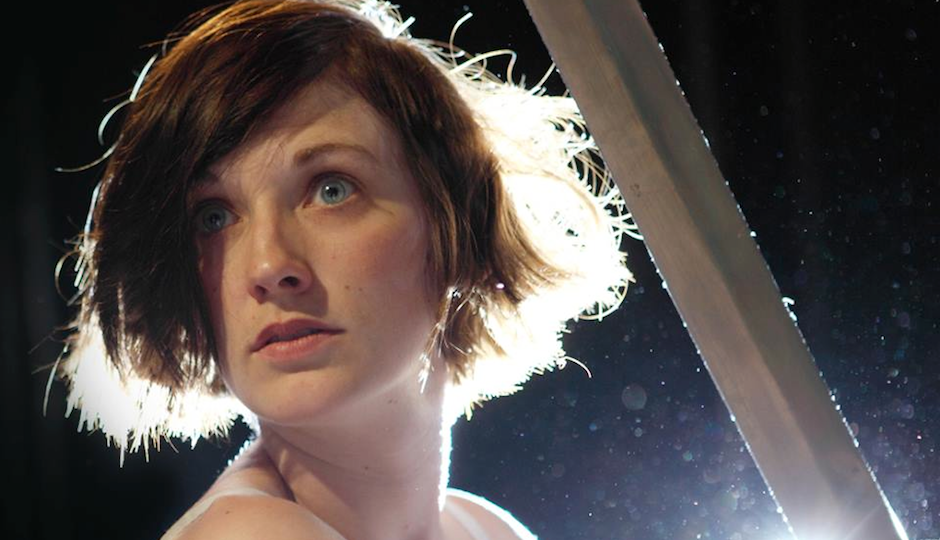Our Chat With Hello! Sadness! Star Mary Tuomanen

Mary Tuomanen
When you talk to Mary Tuomanen, you know are in the presence of a person who’s serious about taking art to the next level. Her theories and philosophies on creating theater are so new, so profound, that you can’t help but stand on pins and needles to see what she’s coming up with next. Currently, Tuomanen is tackling a monumental task: She’s staging her one-woman show Hello! Sadness! at the Kimmel Center after being awarded a Kimmel Center Theater Residency. We had the chance to catch up with the multi-talented writer and actor, who gave us the inside scoop of the process behind her new play.
How did the Kimmel Center’s Theater Residency program help you shape this piece?
The residency was so fruitful. I started this process with a good chunk of the play written—up until this very climactic moment. It’s a very personal and political piece, [so I had to consider my own beliefs] in order to finish what I was writing. I had outlined the problem, but I had to say what I believed about that problem. That was a difficult process, and luckily I’ve had people around me who have helped talk me through that.
I have such a great artistic team—my director has been amazing. It’s been intense. I’m used to devised processes, but it also leaves you very vulnerable—a lot of people who are on the creative team have worked together in the past. The four of us have been through this crucible of questioning our beliefs in a world as artists in a political way. We have a shared vocabulary of how how art can make the world better. This draft, this version of the show, is really close to what I believe now. It’s what I think.
So what is it that you believe?
There’s this notion that the likelihood to succeed in art is minimal, and when you succeed, the result is so small and dismissible that the despair, the sadness, can eat you alive. The show pauses that notion: It divorces that concept, because to try is the point. The success or failure has nothing to do with it. What is art? It doesn’t do anything. Of course, art changes the world, but it won’t be visible in your lifetime. Joan of Arc was arguably a failure in her time. Look at what happened to the Black Panther Party, and then look at what’s going on in the news: It shows the severe consequences of that hole in the culture of race pride, of people who will stand up and say “It’s wrong to shoot a young black man for no cause.” The arc of history is long and we hope that it will go toward justice, but you have to try. It’s crazy to do something when you don’t know how it’ll come out and be like “I don’t care.”
I know the work is being billed as a feminist piece. Can you unravel that for us?
I was originally brought to Kimmel to do Saint Joan Betrayed. It was a piece that was really hard for me to write, but people found it interesting. In my research of Joan of Arc, I was getting aggravated by how she was appropriated by different causes throughout history. Joan was turned into the tropes of “crazy woman” or “female victimhood,” and she could have this hero persona, but as long as she breaks down and cries at the end, it was fine. I just couldn’t write it. For the residency, I didn’t want to write about Joan of Arc unless I could examine the tropes of the crazy woman, the woman alone making art, the woman killing herself. These tropes of victimhood I’ve struggled with a lot. The dominant narrative of society will come into conflict if you are a woman who doesn’t follow those tropes, but you have to assert yourself anyway. It does matter how you define yourself and the story you tell yourself. From a young age before you can understand what’s happening to you, you’re being told these narratives. Feminism has to be the fight to liberate everyone, especially in America.
Philly really seems to be taking off with original works right now. Why do you think that is?
Philly artists have got to get creative during the summer to pay the bills, but it is great because I get to do my own work. During the year, I have to take some Equity jobs to get health insurance. One of the big reasons that we’re seeing these original works is the rich devised community that is always coming up with concepts to fill the spaces between the big houses. With the Pig Iron School happening, it will bring an influx of creatives, young emerging playwrights, and a glut of awesome new plays. Philly can only expand on its platform to present new work, and the community is feeding off of it. It’s really exciting.
When people think of the Kimmel Center, they see this huge conglomerate, but they have so many interesting projects that really help new artists. How do you see them playing a role in the development of new works?
I am so intensely grateful for the Kimmel. The residency changed my life, and it was profound for the other talented writers who were a part of it. There are pieces of art that exist because of that residency that would never have existed. Even if the Kimmel did nothing else, it profoundly impacted American culture. They are constantly looking for new ways to produce new art and thinking about how they can use the things that the Kimmel has to give artists a voice. It will only grow, and it is great that people get opportunities like this in such a huge organization. New art will define this political moment in history, and this nurturing will only grow.
Hello! Sadness! runs at the Kimmel Center’s SEI Innovation Studio June 11th through June 13th. Tickets and more information can be found here.


